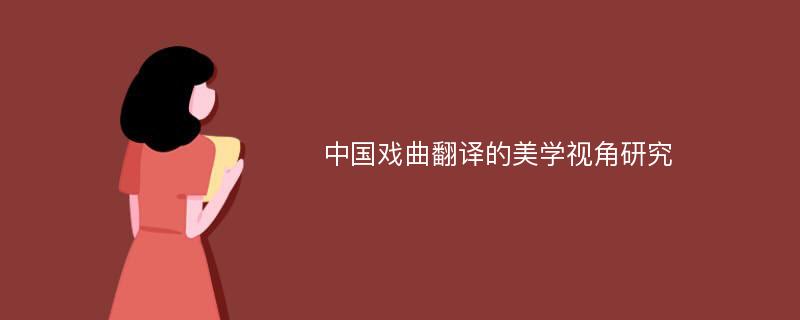
论文摘要
中国戏曲是中华民族宝贵的文化遗产,融诗歌音乐舞蹈美术为一体,是一门综合的表演艺术,同时也是一种重要的文学体裁。戏曲是由中国古代诗词歌赋发展而来,一脉相承。其中的唱词是一种兼具音乐与诗歌的艺术形式,和诗词一样,是讲究平仄、节奏、韵律和字数限制的诗体,而宾白一般为散体,抑扬顿挫铿锵有力,对于表达剧情和展现人物性格有重要作用。如何通过翻译让译语读者了解中国的戏曲艺术,获得美的享受,一直是译者的难题和挑战。在美学中,审美客体是审美主体认识和创造的对象。在翻译中,审美客体是译者所要翻译的原文。戏曲的文学性要求译者充分感知和发掘原文在不同层面上的审美构成,包括表象要素和非表象要素两大系统。其中唱词的音韵节奏及遣词造句带来的视觉听等直观感受给人以形式上的美感,可以由译者的直观感受获得;而唱词中鲜明的意象,“言有尽而意无穷”的审美意境,浓郁的感情色彩和宾白蕴含的语气,则需要译者较高层次的审美能力。在美学中,审美主体是对审美客体进行审美活动的人。对中国戏曲翻译而言,审美主体包括翻译者和读者。一方面,译者充分发挥语言认知能力和审美想象等心理机制,主动调节自己的认知和审美方式,积极建构与原文作者相似的审美经验,捕捉原文的审美信息,译者不同的观察视角和审美判断也能带给读者不同的感受。另一方面,译者也要考虑译语读者的审美文化和方式,提高译文的可接受程度。翻译作为一项特殊的审美活动,不仅包括译者对原文本的审美和鉴赏,还包括在译语中对原文审美构成的再现。本文试从美学的基本理论出发,遵循译者的审美活动规律,在分析中国戏曲作为审美客体其美学构成要素的基础上,对戏曲翻译在形式系统和非形式系统不同层面上实现美的传递的问题进行了初步探索,希望对戏曲翻译的研究有所裨益。
论文目录
相关论文文献
- [1].Overcoming Cerebral Palsy to Be a Professional Translator[J]. China Today 2020(02)
- [2].Translator's Subjectivity in the Choice of the Original Text——A Case Study of Lin Yutang's Six Chapters of a Floating Life[J]. 校园英语 2016(31)
- [3].Taking an Inclusive Approach[J]. ChinAfrica 2016(12)
- [4].The Cross-cultural communication of Confucianism introduced by Lin Yu-tang[J]. 山西青年 2017(02)
- [5].Translating China for Western Readers in the Context of Globalization(PartⅡ)[J]. 翻译论坛 2016(04)
- [6].A Contrastive Study on the Two Chinese versions of Washington Ivring's Rural Life in England[J]. 校园英语 2017(04)
- [7].HEART TO HEART[J]. Beijing Review 2017(21)
- [8].Spotlight on Southwest China's Small Towns[J]. China Today 2017(03)
- [9].Translator's Subjectivity and Translator's Training in the Context of Globalization[J]. 校园英语 2017(12)
- [10].Human Translator and Translation Technology[J]. 校园英语 2017(16)
- [11].Heart To Heart[J]. ChinAfrica 2017(06)
- [12].Analysis on Yan Fu and the Ideological Features in His Time[J]. 校园英语 2017(29)
- [13].A Critical Review on Douglas Robinson's Becoming a Translator: an Introduction to the Theory and Practice of Translation[J]. 校园英语 2017(28)
- [14].拓宽领域深化交流 探索翻译教育的创新发展——国际译联第七届亚洲翻译家论坛综述[J]. 东方翻译 2013(06)
- [15].Shaping a New Economy[J]. ChinAfrica 2020(05)
- [16].On Becoming a Translator[J]. 校园英语 2015(21)
- [17].Deconstructive Reconsideration of Translation[J]. 校园英语 2014(26)
- [18].翻译者地位的改变(英文)[J]. 科技致富向导 2011(20)
- [19].Are Today's Women Fully Empowered?[J]. ChinAfrica 2020(11)
- [20].Functions and Benefits of SDL Translator's Workbench 2007[J]. 海外英语 2012(15)
- [21].Wmatrix-based Study of Translator's Style——A Case Analysis of Two English Versions of The True Story of Ah Q[J]. 海外英语 2017(16)
- [22].Cultural Transmission of language in Translation[J]. 校园英语 2020(20)
- [23].Commentary on My Translation of You Can You Will from Jauss' Perspective of Reception Aesthetics[J]. 海外英语 2017(08)
- [24].Following Fate[J]. Beijing Review 2008(29)
- [25].A Brief Analysis of the Translator's Subjectivity in the Process of Computer Aided Translation[J]. 海外英语 2019(23)
- [26].On Savory's Principles of Translation[J]. 海外英语 2016(03)
- [27].Self-Retranslation as Intralingual Translation:Two Special Cases in the English Translations of San Guo Yan Yi[J]. Language and Semiotic Studies 2017(02)
- [28].A Comparative Analysis of the English Versions of Prelude to Water Melody in Light of Eco-Translatology[J]. 海外英语 2020(03)
- [29].A Study on the Strategies and Influencing Factors of the Subtitle Translation of the Film Mulan from the Perspective of the Rewriting Theory[J]. 海外英语 2019(03)
- [30].On the Requirements and Strategies for Translators in Chinese-English Translation of Tourist Materials[J]. 海外英语 2017(02)
